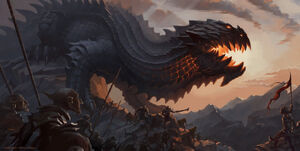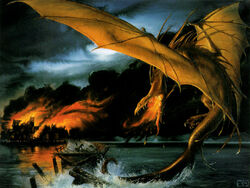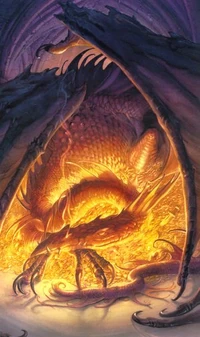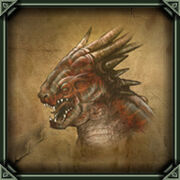DreamBrisdin (talk | contribs) No edit summary |
DreamBrisdin (talk | contribs) No edit summary |
||
| Line 34: | Line 34: | ||
== Description == |
== Description == |
||
| − | Fire-drakes often grew to immense sizes, and shot destructive flames and vapours from their mouths and nostrils. The fire from one of these dragons was so intense that it was said the great dragons could consume and melt the [[Rings of Power]] (as became the case with some of the Dwarven Rings), with the exception of the [[One Ring]].<ref>''[[The Lord of the Rings]], [[The Fellowship of the Ring]]'', Book One, Chapter II: "[[The Shadow of the Past]]"</ref> The fire also emitted extreme heats from their bodies, causing the monsters to dry up a river and ptentially melt their passes. |
+ | Fire-drakes often grew to immense sizes, and shot destructive flames and vapours from their mouths and nostrils. The fire from one of these dragons was so intense that it was said the great dragons could consume and melt the [[Rings of Power]] (as became the case with some of the Dwarven Rings), with the exception of the [[One Ring]].<ref>''[[The Lord of the Rings]], [[The Fellowship of the Ring]]'', Book One, Chapter II: "[[The Shadow of the Past]]"</ref> The fire also emitted extreme heats from their bodies, causing the monsters to glow in the darkness and dry up a river and ptentially melt their passes. |
Most of the famous dragons throughout the ages were fire-drakes, although only some of them fought for Morgoth. |
Most of the famous dragons throughout the ages were fire-drakes, although only some of them fought for Morgoth. |
||
Revision as of 11:09, 14 May 2020
- "Morgoth loosed upon the people of Narog the great host that he had long prepared; and Glaurung the Urulóki passed over Anfauglith."
- —The Silmarillion, Quenta Silmarillion, Chapter XXI: "Of Túrin Turambar"
Fire-drakes (or Urulóki) was one term used for fire-breathing Dragons, and may have been a sub-species.
History
First Age

Glaurung, the Father of Dragons, by Vaejoun
Glaurung and Ancalagon were fire-drakes, and were among the most famous of the breed. Glaurung was a key player in the sacking of Nargothrond and in the fulfillment of Morgoth's curse on the children of Húrin. He was a fearsome bane to the Elves.[1] Ancalagon and his armada of winged fire-drakes by themselves drove back the Host of the Valar during the War of Wrath at the end of the First Age, such was their incredible power.
Fire-drakes also joined the Balrogs in the attack on Gondolin.[2][3]
Second and Third Ages

Smaug over Lake-town, by John Howe
All fire-drakes were thought to have been slain before the Second Age, but some including Smaug survived; in TA 2770 he came down from the North and sacked the Lonely Mountain. Later, in TA 2941, Thrór's grandson Thorin Oakenshield returned with a small group to reclaim his grandfather's kingdom, unleashing a chain of events that led to the death of Smaug when he attacked nearby Lake-town and was slain by the Black Arrow shot by Bard the Bowman.[4]
According to Gandalf, there were still fire-drakes just before the beginning of the War of the Ring as being more like giant scaled serpents with wings than dragons as commonly depicted today.
Description
Fire-drakes often grew to immense sizes, and shot destructive flames and vapours from their mouths and nostrils. The fire from one of these dragons was so intense that it was said the great dragons could consume and melt the Rings of Power (as became the case with some of the Dwarven Rings), with the exception of the One Ring.[5] The fire also emitted extreme heats from their bodies, causing the monsters to glow in the darkness and dry up a river and ptentially melt their passes.
Most of the famous dragons throughout the ages were fire-drakes, although only some of them fought for Morgoth.
Tolkien confirmed in a letter that Smaug was the last of his kind, the last of the "great" fire-drakes of Middle-earth. Dragons of lesser stature, such as smaller kin of Cold-drakes and fire-drakes lived on. This was also mentioned by Gandalf.
Etymology
In Quenya, Fire-drakes were called Urulóki ("Fire Serpent" or "Fire-dragon"[6][7]), from ur ("heat") and lókë ("snake, serpent").[8][9]
Named Fire-drakes

Smaug the Golden, by John Howe
Few fire-drakes were named in J.R.R. Tolkien's legendarium:
Portrayal in adaptations
The Hobbit film trilogy
In The Hobbit: The Desolation of Smaug, Thranduil had claimed to face a "fire drake of the North", and presumably suffered damages caused by dragon's fire. It is unknown whether this dragon was in the First Age, or those in the Grey Mountains in later days including Scatha, but seemingly in the Third Age after Smaug's attack on the Lonely Mountain.
Video games

The Fire Drake in BFME 2
In The Lord of the Rings: The Battle for Middle-earth II, "fire-drake" is redefined as a wingless, four-legged dragon, much different and smaller than Tolkien's dragons or "great worms". They breathe flames, and are used by the Goblin faction. Gorkil the Goblin King can summon three of them as his final power.
"Fire-drake broods" are triplets of smaller fire-drakes, introduced in The Battle for Middle-earth II: The Rise of the Witch-king. They arise in groups of three and their combined attack is just as powerful as their larger cousins; only two fire-drake broods can be recruited at one time.
In The Lord of the Rings: War in the North, Úrgost a winged fire-drake who lives in the Grey Mountains. Agandaûr offers him Nordinbad in exchange for his service to Sauron, Úrgost responds by saying you will have your answer in my own good time. Later on he meets the company Farin, Eradan and Andriel and makes a deal with them to bring him Carn Dûm from Agandaûr and he will not fight for Sauron.
Translations
| Foreign Language | Translated name |
| Afrikaans | Vuur drakes |
| Albanian | Dragoi zjarrit |
| Armenian | Կրակ Դրակոններ |
| Azerbaijani | Yanğın əjdahaya |
| Basque | Sua herensugeak |
| Belarusian Cyrillic | Вогненныя драконы |
| Bengali | আগুন ড্রাগন |
| Bosnian | Vatreni zmajevi |
| Bulgarian Cyrillic | Огнените дракони |
| Cambodian | ភ្លើងឆេះ - នាគ |
| Catalan | Dracs de foc |
| Corsican | Dragoni di focu |
| Croatian | Vatreni zmajevi |
| Czech | Oheň draci |
| Danish | Branddrager |
| Dutch | Vuurdraken |
| Esperanto | Fajrega drakoj |
| Estonian | Tulekahju lohesid |
| Faroese | Eldurdrekar |
| Finnish | Tulikäärmeet |
| French | Drakes d'incendie |
| Frisian | Fjoerdraken (Western) |
| Galician | Dragóns de lume |
| Georgian | ცეცხლი დრაკონები |
| German | Feuerschlange |
| Greek | Φωτιά δράκους |
| Gujarati | ફાયર ડ્રેગન |
| Hebrew | אש דרקונים (Fire-drakes)
אורולוקי (Urulóki) |
| Hindi | आग ड्रेगन |
| Hungarian | Tűz sárkányok |
| Icelandic | Elddrekar |
| Indonesian | Api naga-naga |
| Irish Gaelic | An Dragain dóiteáin |
| Italian | Draghi del fuoco |
| Japanese | 火竜/ウルローキ |
| Kannada | ಬೆಂಕಿ ಡ್ರ್ಯಾಗನ್ಗಳು |
| Kazakh | Өрт драконы (Cyrillic) Ört drakonı (Latin) |
| Korean | 불 드래곤 |
| Kurdish | Ejdeha agir (Kurmanji) |
| Kyrgyz Cyrillic | От-ажыдаарлар |
| Laotian | ໄຟມັງກອນ |
| Latin | Ignis dracones |
| Latvian | Uguns pūķi |
| Lithuanian | Ugnies drakonai |
| Luxembourgish | Feierdraachen |
| Macedonian Cyrillic | Огнени змејови |
| Maltese | Draguni tan-nar |
| Maori | Nga tarakona ahi |
| Marathi | अग्नि ड्रॅगन |
| Mongolian Cyrillic | Гал луу |
| Nepalese | आगो ड्रेगन |
| Norwegian | Branndrager (Bokmål)
Elddrakes (Nynorsk) |
| Old English | Dracan Fyr |
| Persian | آتش اژدهایان (Fire-drakes)
اورولوکی (Urulóki) |
| Polish | Smoki ogniste |
| Portuguese | Dragões de fogo |
| Punjabi | ਅੱਗ-ਡਰੈਗਨ |
| Romanian | Dragoni de foc |
| Russian | Драконы огня |
| Scottish Gaelic | An Dragain teine |
| Serbian | Ватрени змајеви (Cyrillic) Vatreni zmajevi (Latin) |
| Sindhi | باهه ايجنٽ ? |
| Sinhalese | ගිනි මකරෝ |
| Slovak | Požiaru-drakoch |
| Slovenian | Ogenj-zmajev |
| Spanish | Serpiente de Fuego |
| Swedish | Branddrakar |
| Tajik Cyrillic | Оташ аждаҳои |
| Tamil | தீ டிராகன்கள் |
| Telugu | అగ్ని డ్రాగన్లు |
| Thai | มังกรไฟ |
| Turkish | Ateş ejderhalar |
| Ukrainian Cyrillic | Вогонь драконів |
| Urdu | آگ ڈریگن |
| Uzbek | Йонғин аждаҳо (Cyrillic) Yong'in ajdaho (Latin) |
| Vietnamese | Rồng lửa |
| Welsh | Dreigiau tân |
| Xhosa | Ii dragons zomlilo |
| Yiddish | פייַער דראַגאָנס |
| Yoruba | Ina dragoni |
References
- ↑ The Silmarillion, Quenta Silmarillion, Chapter XXI: "Of Túrin Turambar"
- ↑ The Silmarillion, Quenta Silmarillion, Chapter XXIII: "Of Tuor and the Fall of Gondolin"
- ↑ The History of Middle-earth, Vol. II: The Book of Lost Tales Part Two, chapter III: "The Fall of Gondolin"
- ↑ The Hobbit, Chapter XIV: "Fire and Water"
- ↑ The Lord of the Rings, The Fellowship of the Ring, Book One, Chapter II: "The Shadow of the Past"
- ↑ The History of Middle-earth, Vol. II: The Book of Lost Tales Part Two, chapter II: "Turambar and the Foalókë"
- ↑ The History of Middle-earth, Vol. V: The Lost Road and Other Writings, Part Three: "The Etymologies"
- ↑ The Silmarillion, Appendix: Elements in Quenya and Sindarin names
- ↑ Parma Eldalamberon, Words, Phrases and Passages in Various Tongues in The Lord of the Rings by J.R.R. Tolkien
